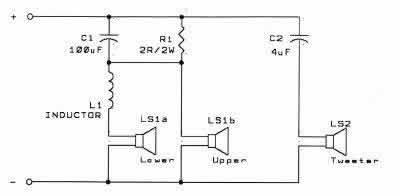
DIY rebuild of the Acoustic Research AR94 loudspeaker
![[AR94]](../jpg/ar94front.jpg)
In 1986, I purchased locally a pair of AR94 speakers. At the time, they cost me approximately US $ 1,000, plus 72% for taxes and duties. To put things in proper perspective, in those days, a typical very good 2-way bookshelf speaker, using an 8" bass driver and a dome tweeter, cost no more than one third of that sum. If we assume a decent bookshelf speaker these days, like for example B&W DM602S2, which currently costs about US$ 700, such proprotions would indicate a current sales price of US$ 2,100-2,500 or so. Add general inflation and you have a grand current total of US$ 3,500-4,000.
In those days, I was a 100% AR man - before these, I used to own a pair of AR5 bookshelf speaker, which were a scaled down version of the legendary AR3a Improved, and used a 10" woofer instead of a 12" unit, yet were not a nominal 4 Ohm load like the 3a, but an easier 8 Ohm load. Those I had for 12 years, and figured it was time to change and step up the ladder. AR's series 9 and 9x was their top-of-the-line series, with mean prices, but also with a mean sound. They sounded good, really GOOD, and not many were able to compete with them. Everybody who was anybody in classical music owned AR speakers, from Karajan to Fischer-Daskau.
Model 94 was near the bottom of the 9x series. To the best of my knowledge, it was the first speaker ever to use what subsequently became known as a 2.5 way system. Instead of one large bass driver, this model uses 2 smaller, 8" (20 cm) doped paper woofers in parallell, but not quite. They go up to about 3 kHz, where they cross over to a 1" (25 mm) dome tweeter. The crossover is a gentle, 6 dB/oct. network, with small phase shifts and nasties.

The mid to treble crossover for the bass units consists of a parallell connection of a bipolar 100uF/50V capacitor and a 2.2 Ohm resistor. However, the lower bass unit has an additional series connected inductor, which is an air core wound unit - the best type, hard to see these days except on top class models. This means that the lower bass unit is rolled off before the upper one, and in that sense, is used more to reinforce the upper unit in the extreme bottom end. The tweeter has a high pass filter consisting of a single 4uF/50V bipolar capacitor; again, a very gentle filter, with as little phase shift as possible.
Connections to the box were made using bottom mounted binding posts, made of reasonable quality metal, but allowing only smaller caliber cables of up to 3 mm.
Despite all this, these were speakers which were not easy to drive. For one thing, their sensitivity was on the lower side, at 87 dB/1W/1m, which means they need about twice the driving power modern speakers, generally rated at 90 dB/1W/1m need. Also, these boxes have some nasty impedance drops, one of them being around 200Hz, where the impedance dips down to 3.9 Ohms, with a phase shift of approximately -53 degrees. This means that the amp sees an effective impedance of about 2.4 Ohms, enough to severely tax commercial units when pushed hard. I have had the opportunity to hear a fair number of them choke, insofar as their protection circuits, typically of the current limiting type, were activated. This generally yields weak and washed out transients, with no blood, thunder and gore.
Anyway, I had them and loved them until late last year. Then, on one occassion, I decided to let them go a little louder than usually. I did so and heard a very distressing sound of harsh mechanical stress, which should not have been there. I took off the cloth which surrounds the speaker and lo and behold - this was an acoustic suspension box no more, nay, it was a weird reflex type! The foam driver surround was literally all gone, and the speaker cones were held in place only by the spiders! I was never nearer to a heart attack, or suicide, as on that day. What to do? Dump the boxes into the garbage can and buy new ones? Or do something about them? I did both - I bought a pair of JBL Ti600 floorstanders, and did something with the ARs.
First, I dug up a guy who came highly recommended as a man capable of making the drivers whole again. I got in touch and took the drivers to him. Sure enough, a week later, the drivers were with new, chemically treated real rubber surrounds.
Hold on, now, I asked, excuse me if I'm wrong, but aren't speakers electro-mechanical devices? Don't the Thiel-Small parameters include some mechanical values as well? I mean, you can't just change the surround for any other surround, as you change the mechanical parameters, which WILL influence the sound, exactly how remains to be seen, er, heard. Yes, he said, but I've been repairing AR speakers for decades now, and I have long ago discovered a German manufacturer who supplies rubber surrounds for specific speakers. AR's 8" units are high on their list.
OK, I said, now that we have them on the operating table, why don't we engage in some serious surgery?
After 14 years, those capacitors merely approximate their initial parameters, they could do with a change. Right, he says. And those binding posts, in those days I used some Italian made speaker cable wire which was 3 mm thick, but now I use Jamo and van den Hul 5 mm speaker cable - I need bigger and preferably better binding posts, gold plated, of course. Right, he says.
OK, let's operate, I said. Hold on, he says, doing all that almost begs you change the tweeter wires as well. Oh yeah, into what, I asked? Well, how about some pure silver braided wire of exactly the same caliber as the original? That's crazy, I said, it's so perverse that I just have to do it.
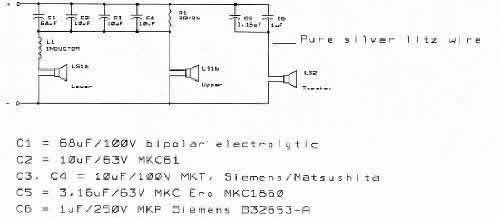
The next few days were spent in the company of an oscilloscope. We were trying to discover which combination of materials in the capacitors would give us the best result. Japanese tweakers have been playing that game for ages now, and I have always thought them right in their reasoning that each and every core technology has its advantages and disadvantages. To obtain as near to a perfect capacitor as is reasonable, one must use different types in parallell - that way, one uses the best of each technology and hopefully decreases the faults they all have. So, the job was to find which combination would do best by passing square waves through different combinations. The one that passed the square wave best would be it. For the uninitiated - square waves approximate a multitude of sine waves, and are thus sometimes considered as nearer to reality than one simple sine wave, but are at the same time a cruel test which can show a lot of data very useful in designing of electronic circuits.
Eventually, we arrived at a parallel connection of one bipolar electrolytic capacitor, rated at 68uF/100V, one MKT 10uF/100V and two MKC 10uF/63V caps. This yields a theoretical total of 98uF, but by measuring each one, we managed to obtain a total capacitance of 100.5uF. Instead of the original 50V rating, we now had no less than 63V.
Exactly the same methodology was applied to the tweeter. We finally settled down on a parallell connection of one 1uF/250V MKP capacitor and one 3.16uF/63V MKC capacitor, yielding an effective total of 4.05 uF.
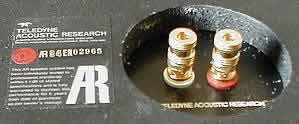
The rest was just a lot of manual labor. The actual crossover is in fact a piece of plywood, with crossover elements stuck into it and soldered wire to wire directly - not elegant, but electrically the best possible solution.
AR really knew how to do it in those days. That made our job a little more difficult, fitting all those caps on, but fortunately, the board was large enough and we did it. The binding posts went in, and new silver wire was inserted.
However, instead of the clamps AR used, we opted for direct soldering, under my pressure - all connections are bad, and good Flutin solder, with silver in it, is still the least bad of them all. Hell, we even soldered the wire to the inside part of the binding posts.
For a while, I was toying with the idea of doing away with the binding posts completely, and soldering the van den Hul 352 hybrid cable directly to the crossover board. That would have been even better, as it would do away with a contact, always good, and considerably cheaper to boot. But I didn't do it, as I anticipated that I might have to test some speaker cables for TNT some time, and that solution would rule out any chance of that.
Actual work took us about 5-6 hours - we didn't hurry. Go slowly and work well.
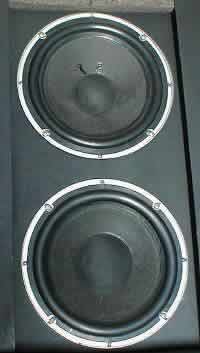
AR invented the acoustic suspension (infinite baffle) principle in 1953, just as they invented the dome speaker - I am eternally grateful to AR and Mr Edgar Villichur for that. What AR had always been famous for was the neutrality of sound they strived for - their thesis was that any speaker "good" for rock and "bad" for classical music, or vice versa, was in fact a bad speaker. A good speaker was good with everything and anything, period. This seems so logical that I seriously challenge anyone to defy this logic. It is my feeling that AR went a very long way in making that theory come true.
To describe the sound of these boxes when new would be short work - in a nutshell, neutral. I played rock on them, I played folk on them, my wife spent years listening to classical music on them, and they just delivered smooth music, period. That is their best side, they are neutral. But neutral does not mean lifeless - on the contrary, they were neutral BECAUSE they were so lifelike, or not neutral if the recording was not neutral. There is some grain of truth in AR's motto "Higher Fidelity".
Initially, these boxes were seamless from top to bottom, nothing pushed and nothing pulled, and that's why I think of them as neutral. They were not in great favour in their day due to their difficulty of drive - too many popular amplifier models in those days had problems with current delivery and just didn't have the guts to drive these speakers properly. You could say that in those days, most amps had balls of glass, and very few had balls of brass, but those that did were a joy to use. Not that they had to be very expensive, no, I remember a small Harman/Kardon integrated, I think its designation was 640, from say 1984 or 1985, with a rating of just 30W or so per channel, which drove these speakers with ease.
While I cannot think of any adjective to truly and honestly describe the color of AR's sound, I was and still am amazed at the depth, volume and control of the bass lines they are capable of. I think this is a good place to note that there is an inherent difference on bass between reflex and acoustic suspension boxes. Bass reflex boxes are, by and large, more efficient, and their bass LINEARITY is generally better than with acoustic suspension. However, reflex boxes will generally drop off very sharply after their cutoff point, whereas acoustic suspension boxes will start to drop off sooner than reflex boxes, but will do so much more gently and with considerably less phase shift. Thus, in practice, one subjectively feels acoustic suspension boxes have just as deep, and sometimes deeper, bass than reflex boxes - this is not really so, but appears to be so because of less phase shift. Something like tubes having a "sweet" sound, when in reality they are delivering 2-5% THD and 1-3% IM distortion, both being above the threshold of hearing. It's hardly true to life, but it sounds good.
Also, it can be shown even by measurement that in general, acoustic suspension boxes will reproduce transients better, and in AR's case much better, than most reflex boxes. This is so because the air in the box, being trapped, acts as a spring which progressively resists cone excursions backwards. This generally yields less bass overhang, since the air tends to prevent the cone from freely vibrating - something that is not possible with reflex enclosures.
Please bear in mind that these are just general comments - I for one don't believe any technology is inherently superior to any other by simply using it. In other words, it's much more important how well any technology is applied than which technology is used. I've heard too many bad acoustic suspension and bad reflex speakers to subscribe to any method as naturally superior - and I've heard some great speakers of both kinds.
Anyway, AR was always able to extract deeper and cleaner bass lines than most, and from relatively small effective volumes, from say 20 litres upwards. Now, AR94 has an effective volume of about 50 litres, and it uses two 8" bass units, which is roughly equivalent to one 12" woofer. But smaller drivers are lighter and presumably stiffer, all other things being equal, so they should be faster to respond and will suffer cone breakup later or higher up the range than large diameter woofers.
When new, these speakers were capable of amazingly deep, but much more important, clean and believable bass lines. In those days, I couldn't find a single reflex box which could match the AR for clean bass in its price bracket. Some had more bass, others had deeper bass, but none had such clean bass.
That was then. Now, all that is just the same, only more so. After two weeks of every day listening to them, I still find it hard to believe what I'm hearing. In all sincerity, I think people from AR would find it hard to believe.
Let's be realistic. Changing old capacitors for new ones will by default produce better sound, simply because the old ones have degraded and just don't cut it any more. Changing old bipolar caps for new, impulse type polycarbonate and polypropylene caps will produce still better results, without fail - but how great is impossible to know in advance, you just have to try it and see. It may be 5%, it may be 50%, it depends on your speaker, and I had a very good speaker to begin with.
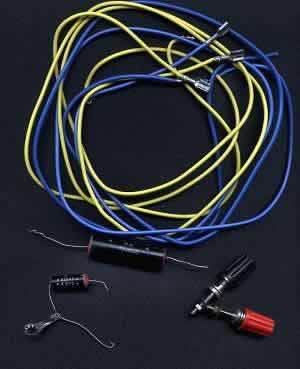
Next, the speaker cable. In those days, I used Italian made 3 mm litz copper cable, properly color coded. In those days, that was much better than what the vast majority used. But these days, I use van den Hul's Hybrid 352 cable, which is 5 mm thick, uses silver plated OFC copper strands in hybrid connection with carbon fibre. Now, I've heard bigger cable, I've heard flatter cable, I've heard expensive and much more expensive cable, but I haven't heard better cable.
I could be deaf over their performance point, or my speakers could be unable to deliver any more over and above this one, but it just doesn't get any better for me than the 352. Whatever, but it remains a fact that this is a much better cable than the one originally used, and so must take at least some of the credit for letting me hear more.
The silver braided wire. Install that and you WILL hear a difference, guaranteed. Again, how great or small, good or bad as per your taste, I really don't know. I find that every time I install it, it produces a slightly softer and more transparent treble, but with less to much less compression, no matter what the speaker, but the better the speaker, the greater the gain. AR94 was no exception, and it had an excellent, though funny looking tweeter to start with.
Finally, the electronics. No doubt I use much better electronics today than I used in those days, even if it is basically the same circuit (my own, by now in Mark XX And Still Counting form - but that's another story). That is a high current design, using four pairs of output transitors in parallell per channel, with a total EFFECTIVE current capability of over 130 Amperes per channel - theoretically, since I never could afford the power supply capable of supplying all that current without stress. But I have always used large toroidal transformers, namely 2x800VA, one for each channel. In brief, I was never short of current, and the circuit never felt current starved. More important, pumping out 25 Amperes is done with distortion still below 0.1% - not many can do that, and those that can cost an arm and a leg.
But this design has evolved over the years, and now just resembles what it used to be then. All changes made were done on sonic merit, meaning they had to sound better or were discarded as meaningless. As for commercial units I keep for the sake of testing, hey, my new Harman/Kardon HK680 is a very refined baby, refined even by H/K standards, and certainly much, much better than what everyone offered in 1986 in that price class.
The point is that today's electronics are better than those in 1986 and will allow much more detail to come through.
Incredible!
I have no other word for it. I hear them, but I still have problems believing what I hear in my own room. And with midrange electronics, too.
They were reasonably fast before - now they are lightning fast. Subjectively, they seem to offer a zero delay time lag. Impossible, of course, but I don't know of any other dynamic speaker which is this fast (as fast as good electrostatics, and they are unmatched for speed).
They were pretty transparent before - now they are superbly transparent, again, better than any other dynamic speaker I can carry by myself I know of. Sure, the B&W 801 is still more transparent, but look at the price and the goddamn weight, you need a crane to sweep the floor beneath it. But the amount of detail is stunning.
A friend, a professional musician, was over the other day and brought along his own music. After some time, he commented that somebody was playing a Gibson, not a Fender guitar. I didn't argue, he seemed positive. Now, think, how many speakers do you know which will let one know of such things? But that got me thinking, so I invited another friend, who is a teacher at the academy of music. I played some music for him and asked if he could tell me anything about it. Sure, he said, what you hear is a Steinway piano with its top cover up. You're sure, I asked, thinking that he may be pulling my leg? Don't be ridiculous, he said somewhat annoyed, after 27 years of playing and teaching piano I should know if its top is up or not. I stopped asking. I was in bliss. Man, that's better than psychotropic drugs!
We come to the bass. It was deep and clean - now it seems still faster, deeper and cleaner. At the risk of being boring, I say it again - I don't know of any other dynamic speaker of this size and/or price which will be able to stand up to this one. I was very worried about the bass because of new rubber surrounds. I feared that they would be too stiff and that bass would be very tight, but less efficient, which would debalance the overall sound towards the bright side. But I need not have worried, the sound stayed as well balanced as ever.
And bass is not just bass, it's true blue thunder when it needs to be. I know that in reality, some speakers I've heard, like the big (some 109 kilo big) JBL speakers must have had a deeper bass, but subjectively, this one is not far behind. It's not just bass, it's thunder, literally. Strong, deep, powerful, vibrant - all the best of bass lines need be.
Some say I'm there already. It's true I loved these speakers when they were new, and they did give me over a decade of great pleasure. But I was on the verge of junking them, and was pulled back by a good and trusted friend, who suggested I try to rebuild them. In 1978, when we met, he walked in and said he had so much money, knew nothing about audio and wanted me to put together a starter system. Today, he uses a Conrad-Johnson preamp, two VTL tube monoblocks and big Infinity speakers - he says he has these speakers only because he couldn't get his hands on AR9s.
I had all but written off these speakers. Obviously, I would have made the mistake of my life had I gotten rid of them somehow. They are not as "analytical" as modern speakers, they don't have the upfront tonal picture of modern speakers, and they do sound sort of "old fashoned". But they are fast as sound, sort of Mach 2 fast, faster than Dynaudio, JBL et al. I have heard, they have a bass to die for and it can turn to thunder. In short, they sound much more right and true to life than the vast majority of today's speakers - or so I think.
It sounds right, and it sounds natural. Unlike too many new speakers. The new generation can talk the talk, but can't walk the walk - AR94 can.
If you have old speakers you like, don't change them just yet. It could be that you can rejuvenate them and enjoy them for many years to come. It could be that you will be as lucky as I was - or hopefully even luckier - to end up with better than you had when new.
It's not very useful pretending to encompass all possible options, so please take the list below as a general guideline only:
A few words on components. Wima is very much in vogue today, manufacturers boast if they use Wima capacitors. Well, I've been using them from day one I started soldering, for over 25 years now. I like them because experience has taught me they are most reliable. However, good as they are, Siemens equivalents are no worse. In short, try for Wima, but don't feel sad if you can find "only" Siemens - you are missing out on nothing, believe me, it's the same thing in all respects except looks. They even cost more or less the same. And they sound the same, trust me, I've tried and retried.
As for possible change of inductors, which could well be ferrite wound in your speaker, it would be nice to replace them with air core ones. But be warned - you need EXACTLY the same value, and factories are notorious for winding very special inductors which don't even know any standards exist.
So, either it's exactly the same value, or don't do it. You will obviously need to measure their values if you can't read them off a diagram or perhaps the crossover board. Visaton of Germany offers special air core inductors, but at fixed values only, no special orders.
And they aren't cheap, no sir, they're relatively costly - US$ 10-40 is quite common, depending on the value.
Then sit back, put on your favorite music and listen for the difference. It may not be obvious, it may not strike you flat in the face, but it will be there. Look for greater clarity and coherence, and especially speed of response - these should show anything from some to big difference in the right direction.
Whew! That's it. Good luck. May the Force be with you.
© 2000 Copyright Dejan Veselinovic - http://www.tnt-audio.com
How to print this article